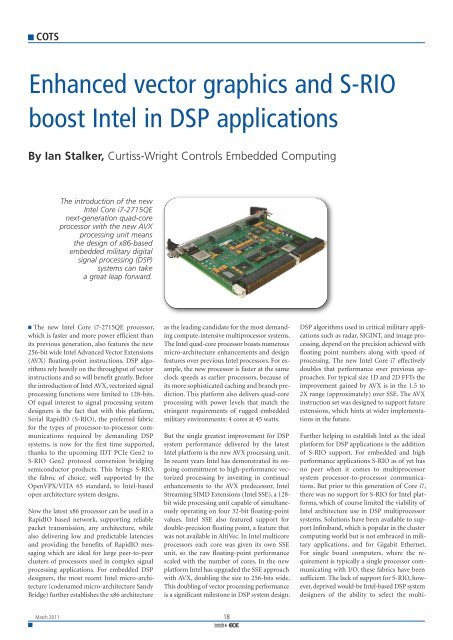Product News - Embedded-Control-Europe.com
Product News - Embedded-Control-Europe.com
Product News - Embedded-Control-Europe.com
Create successful ePaper yourself
Turn your PDF publications into a flip-book with our unique Google optimized e-Paper software.
COTS<br />
Enhanced vector graphics and S-RIO<br />
boost Intel in DSP applications<br />
By Ian Stalker, Curtiss-Wright <strong>Control</strong>s <strong>Embedded</strong> Computing<br />
The introduction of the new<br />
Intel Core i7-2715QE<br />
next-generation quad-core<br />
processor with the new AVX<br />
processing unit means<br />
the design of x86-based<br />
embedded military digital<br />
signal processing (DSP)<br />
systems can take<br />
a great leap forward.<br />
n The new Intel Core i7-2715QE processor,<br />
which is faster and more power efficient than<br />
its previous generation, also features the new<br />
256-bit wide Intel Advanced Vector Extensions<br />
(AVX) floating-point instructions. DSP algorithms<br />
rely heavily on the throughput of vector<br />
instructions and so will benefit greatly. Before<br />
the introduction of Intel AVX, vectorized signal<br />
processing functions were limited to 128-bits.<br />
Of equal interest to signal processing system<br />
designers is the fact that with this platform,<br />
Serial RapidIO (S-RIO), the preferred fabric<br />
for the types of processor-to-processor <strong>com</strong>munications<br />
required by demanding DSP<br />
systems, is now for the first time supported,<br />
thanks to the up<strong>com</strong>ing IDT PCIe Gen2 to<br />
S-RIO Gen2 protocol conversion bridging<br />
semiconductor products. This brings S-RIO,<br />
the fabric of choice, well supported by the<br />
OpenVPX/VITA 65 standard, to Intel-based<br />
open architecture system designs.<br />
Now the latest x86 processor can be used in a<br />
RapidIO based network, supporting reliable<br />
packet transmission, any architecture, while<br />
also delivering low and predictable latencies<br />
and providing the benefits of RapidIO messaging<br />
which are ideal for large peer-to-peer<br />
clusters of processors used in <strong>com</strong>plex signal<br />
processing applications. For embedded DSP<br />
designers, the most recent Intel micro-architecture<br />
(codenamed micro-architecture Sandy<br />
Bridge) further establishes the x86 architecture<br />
as the leading candidate for the most demanding<br />
<strong>com</strong>pute-intensive multiprocessor systems.<br />
The Intel quad-core processor boasts numerous<br />
micro-architecture enhancements and design<br />
features over previous Intel processors. For example,<br />
the new processor is faster at the same<br />
clock speeds as earlier processors, because of<br />
its more sophisticated caching and branch prediction.<br />
This platform also delivers quad-core<br />
processing with power levels that match the<br />
stringent requirements of rugged embedded<br />
military environments: 4 cores at 45 watts.<br />
But the single greatest improvement for DSP<br />
system performance delivered by the latest<br />
Intel platform is the new AVX processing unit.<br />
In recent years Intel has demonstrated its ongoing<br />
<strong>com</strong>mitment to high-performance vectorized<br />
processing by investing in continual<br />
enhancements to the AVX predecessor, Intel<br />
Streaming SIMD Extensions (Intel SSE), a 128bit<br />
wide processing unit capable of simultaneously<br />
operating on four 32-bit floating-point<br />
values. Intel SSE also featured support for<br />
double-precision floating point, a feature that<br />
was not available in AltiVec. In Intel multicore<br />
processors each core was given its own SSE<br />
unit, so the raw floating-point performance<br />
scaled with the number of cores. In the new<br />
platform Intel has upgraded the SSE approach<br />
with AVX, doubling the size to 256-bits wide.<br />
This doubling of vector processing performance<br />
is a significant milestone in DSP system design.<br />
March 2011 18<br />
DSP algorithms used in critical military applications<br />
such as radar, SIGINT, and image processing,<br />
depend on the precision achieved with<br />
floating point numbers along with speed of<br />
processing. The new Intel Core i7 effectively<br />
doubles that performance over previous approaches.<br />
For typical size 1D and 2D FFTs the<br />
improvement gained by AVX is in the 1.5 to<br />
2X range (approximately) over SSE. The AVX<br />
instruction set was designed to support future<br />
extensions, which hints at wider implementations<br />
in the future.<br />
Further helping to establish Intel as the ideal<br />
platform for DSP applications is the addition<br />
of S-RIO support. For embedded and high<br />
performance applications S-RIO as of yet has<br />
no peer when it <strong>com</strong>es to multiprocessor<br />
system processor-to-processor <strong>com</strong>munications.<br />
But prior to this generation of Core i7,<br />
there was no support for S-RIO for Intel platforms,<br />
which of course limited the viability of<br />
Intel architecture use in DSP multiprocessor<br />
systems. Solutions have been available to support<br />
Infiniband, which is popular in the cluster<br />
<strong>com</strong>puting world but is not embraced in military<br />
applications, and for Gigabit Ethernet.<br />
For single board <strong>com</strong>puters, where the requirement<br />
is typically a single processor <strong>com</strong>municating<br />
with I/O, these fabrics have been<br />
sufficient. The lack of support for S-RIO, however,<br />
deprived would-be Intel-based DSP system<br />
designers of the ability to select the multi-
















